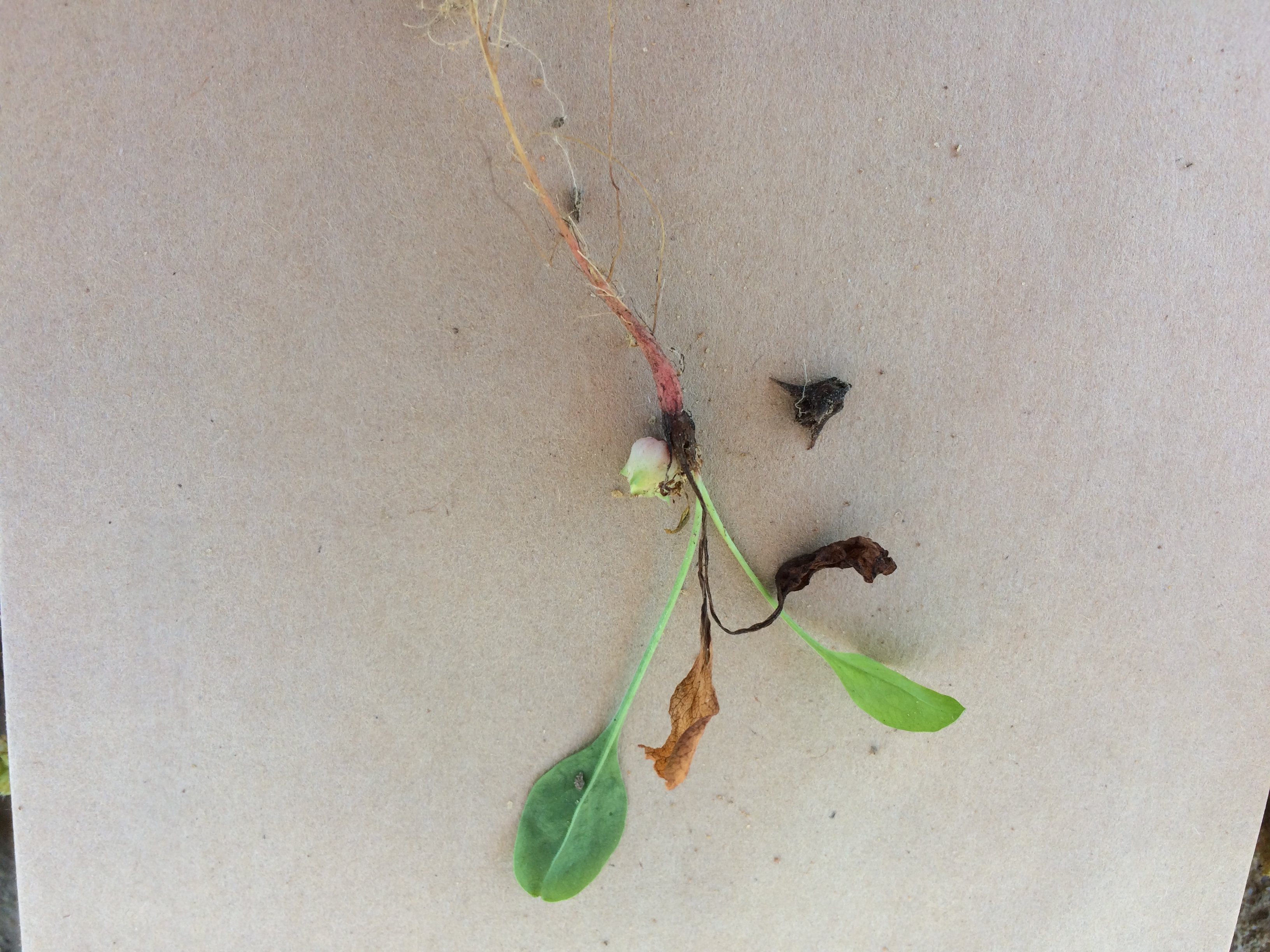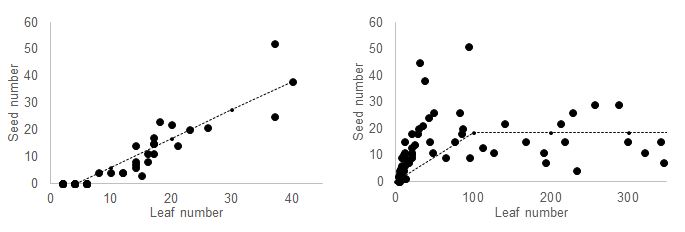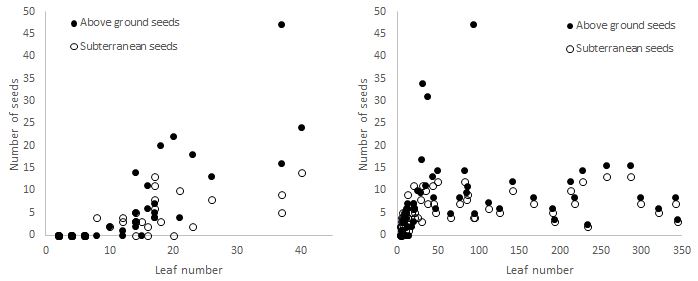Doublegee’s Seedy Secret.
Author: Dr Catherine Borger, Dr Abul Hashem (Department of Primary Industries and Regional Development, (DPIRD) Western Australia). | Date: 25 Feb 2019
Key messages
- Doublegee produces both above ground seed, on the branches, and subterranean seed, at the base of the plant crown.
- Subterranean seed can be produced from the 4 leaf stage, prior to the development of seeds on the plant branches.
- The early development of subterranean seeds in the field plants (at the 4 leaf stage) indicates that spraying at the 2 to 4 leaf stage will not prevent all seed set.
Aims
Doublegee (Rumex hypogaeus T.M.Schust. & Reveal, synonym Emex australis Steinh.) are broadleaved, branching plants with a prostrate growth habit. Doublegee is the fifth most costly weed in WA agriculture, with growers losing $754 000 per year through revenue loss (Llewellyn et al, 2016). Gilbey (1974) found over 50% yield loss in wheat from doublegee densities of approximately 50 to 120 plants/m2. Individual plants can produce over 1100 seeds along the branches, but also produce subterranean seeds at the base of the plant crown (Moore, 2017; Peltzer & Douglas, 2017). These subterranean seeds are difficult to spot without digging up the plant and timing of seed production has not been investigated. This research aimed to determine when and how many underground seeds are produced compared to the production of above ground seed, in field or controlled conditions.
Method
Screen house trial
Doublegee seed was harvested from the Wongan Hills district in 2017. Seed was stored in a glasshouse (with no air-conditioning) over the summer of 2017/2018, at the Department of Primary Industries and Regional Development (DPIRD) Northam office. On 21 May 2018, 6 pots were filled to within 2cm of the top with 5kg of potting mix per pot. Twenty five seeds were planted per pot at a depth of 1cm. Pots were maintained in the screen house, and watered and fertilised as necessary to ensure healthy plant growth. Seedlings emerged by 28 May 2018, and plants were harvested from an age of 33 days (2 leaf) to 115 days (Table 1). Note that after the 6 leaf stage, individual plants of the same age had wide variation in the number of leaves per plant. Plants were harvested up to the stage where maximum subterranean seed production was determined, i.e. 115 days old. Following harvest, the root was removed, and leaf number, subterranean seed number and above ground seed number were counted. Above ground dry biomass was assessed after plants were dried at 60oC for three days.
Table 1. The harvest date of doublegee plants, plant age, number of leaves (range), growth stage and number of plants harvested at each date.
| Harvest date | Age (days) | Leaf number | Growth stage | Number of plants harvested |
|---|---|---|---|---|
| 29/06/2018 | 33 | Vegetative | 10 | |
| 17/07/2018 | 51 | 4 | Vegetative | 10 |
| 9/08/2018 | 74 | 6 | Vegetative-Flowering | 10 |
| 6/9/2018 | 102 | 8-37 | Seed production | 14 |
| 19/09/2018 | 115 | 10-37 | Seed production | 10 |
Field trial
Seed from the same source as used in the screen house trial were manually spread at DPIRD Wongan Hills Research Station on 22 May 2018, on a yellow sandy soil. The site had been sown to Mace wheat during the previous two years and was again sown to Mace wheat at 80kg/ha on 24 May 2018, with 80kg/ha MacroPro® Plus fertiliser (10:14.1:8.4:7.9:0.1:0.2 NPKSCuZn), at a depth of 3-4cm, with knife points and press wheels. Doublegee (67 plants) were harvested over the following months (Table 2). Date of emergence was not recorded for field plants and so plant age is unknown. Harvested plants were processed as for the screen house trial.
Table 2. The harvest date of doublegee plants, number of leaves (range), growth stage and number of plants harvested at each date.
| Harvest date | Leaf number | Growth stage | Number of plants harvested |
|---|---|---|---|
| 24/08/2018 | 4-13 | Flowering-Seed production | 10 |
| 20/09/2018 | 4-35 | Flowering-Seed production | 18 |
| 14/09/2018 | 11-37 | Seed production | 2 |
| 19/10/2018 | 5-94 | Seed production | 7 |
| 12/11/2018 | 21-342 | Seed production | 30 |
Statistical analysis
Linear regression was used to compare above ground dry biomass or leaf number to total seed production, subterranean seed production or above ground seed production, for field and screen house plants. Linear regression with groups was used to compare dry biomass or leaf number to seed production, using location (screen house or field) as the grouping factor. Where linear correlation was low, regression using standard curves was applied, with the origin constrained. Accumulated analysis of variance was used to determine if there was a significant effect of grouping by location (VSN International, 2017).
Results
The development of doublegee plants was highly variable. In the screen house, plants at the 2, 4 and 6 leaf stage did not produce seeds. At the 8 leaf stage, screen house plants had subterranean seeds, and by the 10 leaf stage plants produced above ground seeds. However, some plants as large as 15 leaves had no above ground seeds and only subterranean seeds. By comparison, field plants produced subterranean seeds from the 4 leaf stage and the first above ground seeds could develop at the 5 leaf stage (Figure 1). However, field plants could be as large as 13 leaves and have no above ground seeds, although subterranean seeds continued to form.

Figure 1. A 4 leaf doublegee from the field trial with one fully mature (brown) and one immature (white) seed that formed at the base of the crown, underground.
The size of the plants harvested in each location ranged from 2 leaves (0.065g above ground dry biomass) to 37 leaves (6.75g biomass) for screen house plants and 4 leaves (0.06g biomass) to 342 leaves (27.75g biomass) for field plants. The maximum number of subterranean seeds on a single plant was similar in the two environments, reaching 13 on field plants and 14 on screen house plants. In the current study, total above ground seeds on both individual screen house plants and individual field plants reached a maximum of 47. Note that doublegee plants in the field can produce over 1100 above ground seeds (Moore, 2017). As stated in the methods, plants were only harvested up to the stage where maximum subterranean seed production was determined.
Regression indicated a significant relationship between leaf number or dry biomass and total seed production (dry biomass data not presented) for both screen house and field plants, although the correlation (R2 value) for field plants was low (Figure 2).
Figure 2. The correlation between total seed production and leaf number, for plants grown in the screen house (left) or field (right). The dotted lines indicate the linear relationship between leaf and seed number for screen house plants (y = 1.0666x – 4.634, R2 = 86.5, P <0.001) and field plants (y = 18.4 – 26.32*0.9129X, R2 = 39.1, P <0.001).
Screen house plants had a significant correlation between leaf number and above ground seeds (y = 0.767x – 3.71, R2 = 67.8, P<0.001) and leaf number and subterranean seeds (y = 0.299x – 0.919, R2 = 57.6, P<0.001, Figure 3). The correlation between dry biomass and seed number was also significant, but lower than the correlation between leaf number and seed number (data not presented).
Field plants did not have a high correlation between leaf number and above ground seeds (R2 = 3.5, P = 0.072) or subterranean seeds (R2 = 11.8, P: 0.003). Again, the correlation between dry biomass and seed number was lower than the correlation for leaf number (data not presented).
Figure 3. Above ground or subterranean seeds and leaf number in the screen house plants (left) and field plants (right).
Conclusion
Doublegee under field conditions produced seed at an earlier leaf stage than screen house plants, with subterranean seed at the 4 leaf stage and above ground seed at the 5 leaf stage. Since this early seed production was not evident in the screen house plants, initiation of flowering may be in response to stress related to limited resources in the field compared to the screen house. The recommendation to spray doublegee at the 2 to 4 leaf stage on many herbicide labels will be too late to completely prevent seed set in those populations producing seed at the 4 leaf stage. This early seed production highlights a potential reason why earlier studies have stated that doublegee can be controlled annually, but complete eradication is not possible (Cheam, 1996). Despite this, the staggered germination of doublegee makes it impractical to spray at the 1-3 leaf stage, even assuming the crop is at the correct growth stage (Borger & Hashem, 2018). While the majority of seed production is prevented by killing plants at the 2 to 4 leaf stage, the use of a pre-emergent residual herbicide is necessary to completely prevent seed set.
Doublegee growth and development was highly variable, more so in the field plants than the screen house plants, which confirms the findings of prior research (Borger & Hashem, 2018). In the current study, subterranean and above ground seed production was similar between field plants and screen house plants (13-14 subterranean seeds and 47 above ground seeds), but some field plants were much larger than screen house plants before they produced seeds (i.e. maximum size of 37 leaves for the screen house plants and 342 leaves for the field plants). Research on wild radish (Raphanus raphanistrum L.) indicated that initial seed size influenced plant size and total seed production, with more variation in field plants than glasshouse plants (Stanton, 1984). Further research is therefore required to understand the parameters that influence doublegee growth and development. However, it is clear that the staggered germination, variable growth rates and variation in the timing of initial seed set will complicate the development of effective management strategies for this species.
References
Borger CPD & Hashem A (2018) Recruitment and fecundity of annual ryegrass, great brome grass, barley grass, doublegee and sowthistle. In: 21st Australasian Weeds Conference. The Weed Society of NSW, Manly, Sydney.
Cheam AH (1996) Doublegee (Emex australis Steinh.) seed banks. Plant Protection Quarterly 11, 141-142.
Gilbey DJ (1974) Estimating yield losses in wheat resulting from infestation by doublegee (Emex australis). Australian Journal of Experimental Agriculture and Animal Husbandry 14, 656-657.
Llewellyn R, Ronning D, Clarke M, Mayfield A, Walker S & Ouzman J (2016) Impact of weeds on Australian grain production: the cost of weeds to Australian grain growers and the adoption of weed management and tillage practices. INTERNET, available at: https://grdc.com.au/Resources/Publications/2016/03/Impact-of-weeds-on-Australian-grain-production (last accessed 20 March 2018)
Moore J (2017) Spiny emex. Herbiguide. INTERNET, available at: http://www.herbiguide.com.au/Descriptions/hg_Spiny_Emex.htm (last accessed 12 January 2017)
Peltzer S & Douglas A (2017) Doublegee. INTERNET, available at: https://www.agric.wa.gov.au/grains-research-development/doublegee (last accessed 12 January 2017)
Stanton ML (1984) Seed variation in wild radish: effect of seed size on components of seeling and adult fitness. Ecology 65, 1105-1112.
VSN International (2017) GenStat for Windows 15th edition. VSN International, Hemel Hempstead, UK.
Acknowledgments
The research undertaken as part of this project is made possible by the significant contributions of growers through both trial cooperation and GRDC investment, the authors would like to thank them for their continued support. We would also like to thank Nerys Wilkins, Peter Gray, Shari Dougall and Bruce Thorpe at the Wongan Hills Research station. Thanks are due to Andrew Storrie (AGRONOMO) for reviewing this paper.
GRDC Project Code: UA00156,
Was this page helpful?
YOUR FEEDBACK


